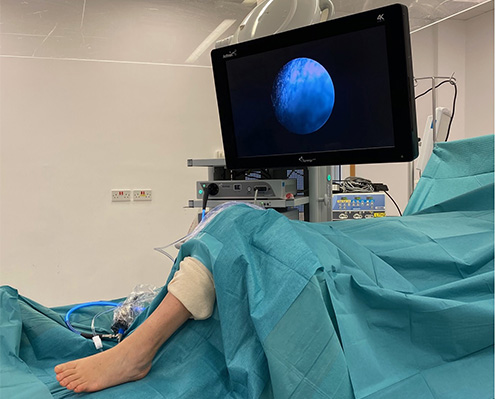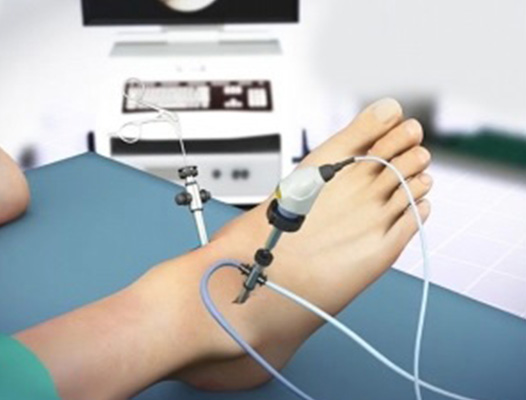What is ankle arthroscopy?
Ankle arthroscopy is key-hole surgery or minimally invasive surgery into the ankle joint using a small camera called an ‘arthroscope’. This allows Mr Davda to visualise the entire ankle joint and treat a variety of conditions. Small fine instruments measuring only a few millimetres can then be used to deal with any injuries or conditions seen.
What are the benefits of ankle arthroscopy?
The benefits of arthroscopy compared to the alternative, open ankle surgery, include:
- Smaller incisions
- Minimal soft tissue trauma
- Less pain
- Faster healing time
- Lower infection rate
- Less scarring
- Earlier mobilisation
- Shorter hospital stay
Why is it performed?
An arthroscopy is performed for a variety of conditions affecting the ankle such as cartilage damage, soft tissue inflammation and overgrown bone. Recovery and success rates vary depending on the specific condition being treated and will be discussed with you prior to surgery.
Before surgery
Your fitness for surgery and symptoms will be reassessed in our pre assessment clinic, which usually takes place prior to the date of operation. Blood tests, further investigations of the heart and lungs may be required to ensure you are fit to have a general anaesthetic.
We kindly ask that you contact us if you suffer an insect bite, cut or bruise to the symptomatic ankle in the period leading up to your surgery. Any injury to the skin in the area of your intended surgery can increase the risk of infection. You may need reassessment and surgery reorganised for another time.
On the day of surgery
You will be seen by Mr Davda or a member of the team to check your consent and mark the leg. Ankle arthroscopy is carried out under general anaesthetic which means you will be asleep for the surgery. Your anaesthetist will discuss this with you prior to surgery.
In most cases, you will be able to go home the same day. Sometimes, it is necessary to spend a night in hospital depending on your general health and immediate recovery from the operation. Local anaesthetic is also applied at the time of surgery to provide pain relief and numb the ankle. This can last for up to a day thereafter.
The operation
The operation itself involves making two small incisions over the front of ankle joint and inserting a camera to look inside the joint. Further work inside in the ankle is carried out using small instruments. Saline water is required to gently inflate the joint to allow good visualisation throughout the ankle, hence it may look and feel swollen for several weeks after surgery. The time taken to perform surgery will depend on the underlying condition treated, but is generally 30-60 minutes. A tourniquet is used around the top of the thigh, hence this may feel sore following surgery. Non dissolving stitches may be used to close the wounds and require removal 2 weeks thereafter. The whole process of being taken to theatre, waking up from anaesthetic and being brought back to the ward will take half a day.

The figure above shows the typical set up used in preparation for key hole surgery of the ankle. A high definition monitor provides a crystal clear image of the ankle. A thorough evaluation of the ankle can be made.

The illustration above shows the typical size of the camera and instruments used. These are smaller than the size of pen.
How long does recovery take?
Most patients who have had ankle arthroscopy take between 7-14 days to recover. There will be a padded dressing and bandage over the ankle joint. Please ensure that the wound dressings are kept dry until you are seen in clinic. Stitches will be removed either in the post operative clinic or by the local practice nurse at about 2 weeks following surgery.
In most instances, I would advise keeping the ankle elevated on 2-3 pillows for the first two days. The knee, ankle and toes can all be moved during this time. Full weight as much as comfort allows can be placed through the ankle after two days. In certain cases, a temporary cast is necessary for 7-10 days, followed by a walking boot for four weeks. Occasionally crutches will be needed to help you mobilise. A physiotherapist will discuss this with you on the ward prior to discharge and ensure you are safe to go home.
Swelling is common after foot and ankle surgery and may last several months. This is best managed by elevating the foot at regular intervals.
When can I go back to work?
This will depend on the type of work you do. For example, if you have a desk job you should be able to return to work after a week. If however you do manual work, 4-6 weeks off work may be required.
When can I drive?
Manual cars can be driven once the ankle has been reviewed in the post-operative clinic. Automatic cars may be driven sooner in those who have surgery on the left ankle only. It is important to be able to perform an emergency stop. You are advised to contact your insurance company to ensure you are covered to drive.
What are the possible complications?
The rate of complications following ankle arthroscopy as low, but as with all surgery, there are risks. These are:
- Infection
- Injury to a nerve resulting in numbness over the top of the foot. This normally resolves over the course of six months, but in a few rare cases can be permanent.
- Recurrence of symptoms - this depends on the condition being treated.
- Persistence of swelling. This may last for several months and is a side effect, rather than a complication of surgery
- Deep vein thrombosis or pulmonary thrombosis. This is exceedingly uncommon (less 1/1000). Medication to thin the blood may be required in certain patients with pre existing conditions, or where a the leg has to be placed in cast. This medication may be in the form of a self administered injection, or a tablet. Further information on how to self administer the blood thinning medication is here
